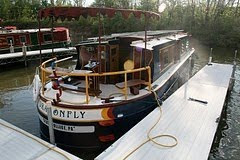We're in Morehead City, NC, approaching the dreaded Pamlico Sound today. (More on that anon). A friend asked recently, "Why are nuclear plants so often sited on coastlines?" The answer is simple: When you need a whole lot o' cooling power, only the ocean will do.
 |
| Landmark event: Repairman on deck! |
We've been thinking about the cooling power of water the last couple days, because
Dragonfly narrowly avoided a meltdown. OK. I joke around a lot. The situation in Japan is no joking matter. I tell our story in the spirit of, "This adventure gave us a
tiny insight into the horrors of 'not enough cooling power.' "
When the wind or current is strong, we have to use our diesel engine, which is water-cooled, using whatever water we are driving through at the time. Water is sucked in; it flows through a counter-current exchange system--much like your car's radiator--and it's returned to the environment, getting rid of excess engine heat.
Late last week Cap noticed a sharp drop in our coolant reservoir. There was no obvious coolant in the bilges. So apparently the system wasn't leaking. Where was the coolant going?
He ran over the engine plumbing with a finetoothed comb. No clues.
This was a serious situation, because we're crossing some big water, and if a boat engine gets too hot, well, it's like a nuclear power plant. You can have a meltdown. No radioactivity. But total annihilation of your power plant, for sure.
So, after internal resources were exhausted, Cap acted like a prudent head of state. He invited help from an expert. He ALLOWED A REPAIRMAN TO COME ON THE BOAT.





























